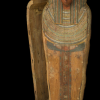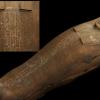New Light on Scribal Practice in the Dakhla Oasis (Excavations at Amheida, Egypt))
During the excavation season at Amheida this year, a reassessment of local scribal practices in the Dakhla Oasis in the Roman era revealed a number of connections and trends through multiple forms of evidence, namely archaeological (small finds), art historical (tomb walls), architectural (buildings), papyrological (paleography), and ceramic (ostraka). The preliminary results of this study show that scribal practices in the Dakhla Oasis adhere to those elsewhere in the Roman Empire despite its extreme geographical remoteness.








